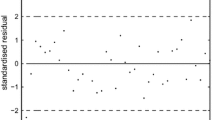Abstract
The main purpose of this paper is to investigate the sensitivity analysis of structural equation model when minor perturbation is introduced. Some influence measure that based on the general case weight perturbation is derived for the generalized least squares estimation. An influence measure that related to the Cook's distance is also developed for the special case deletion perturbation scheme. Using the proposed methodology, the influential observation in a data set can be detected. Moreover, the general theory can be applied to detect the influential parameters in a model. Finally, some illustrative artificial and real examples are presented.
Similar content being viewed by others
References
Beckman, R. J., & Cook, R. D. (1983). Outliers.Technometrics, 25, 119–149.
Bentler, P. M. (1983). Some contribution to efficient statistics for structural models: Specification and estimation of moment structures.Psychometrika, 48, 493–517.
Bentler, P. M. (1992).EQS: Structural Equation Program Manual. Los Angeles: BMDP Statistical Software.
Browne, M. W. (1974). Generalized least squares estimators in analysis of covariance structures.South African Statistical Journal, 8, 1–24.
Browne, M. W. (1982). Covariance Structures. In D. M. Hawkins (Ed.),Topics in applied multivariate analysis (pp. 72–141). Cambridge: Cambridge University Press.
Cook, R. D. (1979). Influential observations in linear regression.Journal of the American Statistical Association, 74, 169–174.
Cook, R. D. (1986). Assessment of local influence (with discussion).Journal of the Royal Statistical Society, Series B, 48, 133–169.
Cook, R. D., and Weisber, S. (1982).Residuals and influence in regression. New York and London: Chapman and Hall.
Critchley, F. (1985). Influence in principal component analysis.Biometrika, 72, 627–636.
Hayduk, L. A. (1987).Structural equation modeling with LISREL. Baltimore, MD: Johns Hopkins University.
Hilton, T. L. (1969).Growth study annotated bibliograph (Progress Report 69-11). Princeton, NJ: Educational Testing Service.
Huber, P. S. (1981).Robust statistics. Wiley, New York.
IMSL (1991).FORTRAN Subroutines for statistical analysis. Houston, TX: Author.
Johnson, W., & Geisser, S. (1983). A predictive view of the detection and characterization of influential observations in regression analysis.Journal of the American Statistical Association, 78, 137–144.
Jöreskog, K. G. (1978). Structural analysis of covariance and correlation matrices.Psychometrika, 43, 443–447.
Jöreskog, K. G., & Sörbom, D. (1988).LISREL IIV: A Guide to the program and applications, Chicago, IL: SPSS.
Land, K. V., & Felson, A. E. (1978). Sensitivity analysis of arbitrary identified simultaneous-equation models.Sociological Methods and Research, 6(3), 283–307.
Leamer, E. E. (1984). Global sensitivity results for generalized least squares estimate.Journal of the American Statistical Association, 79, 867–870.
Mardia, K. V., Kent, J. T., & Bibby, J. M. (1979).Multivariate analysis. Academic Press.
Pack, P., Jolliffe, I. T., & Morgan, B. J. T. (1988). Influential observations in principal component analysis: A case study.Journal of Applied Statistics, 15, 37–50.
Polasek, W. (1984). Regression diagnostics for general linear regression models.Journal of the American Statistical Association, 79, 336–340.
Tanaka, Y. (1988). Sensitivity analysis in principal component analysis: Influence on the subspace spanned by principal component.Communications in Statistics, Series A, 17, 3157–3175.
Tanaka, Y., & Odaka, Y. (1989a). Influential observations in principal factor analysis.Psychometrika, 54, 475–485.
Tanaka, Y., & Odaka, Y. (1989b). Sensitivity analysis in maximum likelihood factor analysis.Communications in Statistics, Series A, 18, 4067–4084.
Tanaka, Y., & Watadani, S. (1992). Sensitivity analysis in covariance structure analysis with equality constraints.Communications in Statistics, Series A, 21, 1501–1515.
Tanaka, Y., Watadani, S., & Inoue, K. (1992). Sensitivity analysis in structural equation models. In Y. Dodge & J. Whitterker (Eds.), COMPSTAT 1992Physica-Verlag, 1, 493–498.
Tanaka, Y., Watadani, S., & Moon, S. H. (1991). Influence in covariance structure analysis: With an application to confirmatory factor analysis.Communications in Statistics, Series A, 20, 3805–3821.
Watadani, S., & Tanaka, Y. (1994). Statistical software SACS—Sensitivity analysis in covariance structure analysis.Technical Report of Okayama Statistical Association, 58.
Author information
Authors and Affiliations
Additional information
The research of the first author was supported by a Hong Kong UPGC grant. The authors are greatly indebted to two reviewers for some very valuable comments for improvement of the paper.
Rights and permissions
About this article
Cite this article
Lee, SY., Wang, S.J. Sensitivity analysis of structural equation models. Psychometrika 61, 93–108 (1996). https://doi.org/10.1007/BF02296960
Received:
Revised:
Issue Date:
DOI: https://doi.org/10.1007/BF02296960




